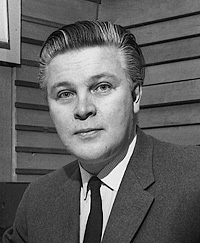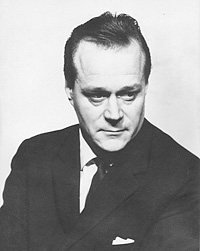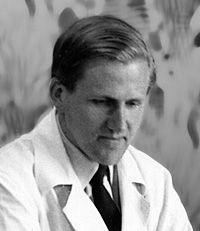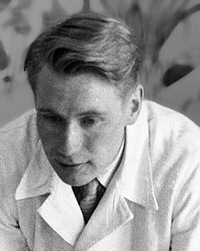| |
|
|
|
|
|
|
|
| |
PIHLAJAMÄKI ARCHITECTURE PATH |
|
| |
|
|
|
|
|
|
|
| |
PIHLAJAMÄKI'S DESIGNERS |
|
|
|
|
|
|
|
|
|
|
|
 |
|
|
|
|
|
|
|
|
|
|
|
|
Uuskuva Studio |
|
|
|
|
|
|
|
 |
|
Architect, Professor Olli Kivinen 1921-1998
Architect Olli Kivinen drew up Pihlajamäki’s town plan during the years 1959-1964. In 1960 Kivinen was appointed Otto-Iivari Meurman’s successor as Professor of Town Planning at the University of Technology. At Pihlajamäki, Olli Kivinen developed Meurman’s concepts of “cells” as an organising factor in suburban housing; parking requirements were among the new factors that emerged.
Pihlajamäki’s town plan exhibits strong aesthetic ideals that nevertheless serve an efficiency-based society. Beginning with Olli Kivinen’s first sketches, solutions were sought for Pihlajamäki that took the character of each sub-area into account while simultaneously establishing a consistent townscape. Pihlajamäki’s buildings are placed on the landscape like huge sculptures – a dialogue emphasising the dramatic contrast between the buildings and the rocky landscape dominated by pine trees.
Presentation Back |
|
|
|
|
|
|
|
|
|
|
|
|
|
|
|
|
|
|
Lauri Silvennoinen archives |
|
|
|
|
|
|
|
 |
|
Architect Lauri Sivennoinen 1921-1967
Lauri Silvennoinen played a key role as an advocate of industrialised construction in Finland. In the exhibition catalogue for the PRE-FAB exhibition, Silvennoinen emphasised the importance of process construction and urbanisation. Instead of thinking of a building as a product, Silvennoinen focused his attention on processes. Through this Silvennoinen believed that the construction industry’s possibilities were virtually unlimited. At its most basic, the concept was “that people could use their time better”.
Pihlajamäki’s Sato area became the most important application of Lauri Silvennoinen’s ideas as well as an important milestone with respect to the future development of the Finnish construction industry. The front of white buildings designed by Silvennoinen can be seen from afar in the overall landscape and has become the symbol of Pihlajamäki.
Presentation Back |
|
|
|
|
|
|
|
|
|
|
|
|
|
|
|
|
|
|
Sulo Savolainen archives |
|
|
|
|
|
|
|
 |
|
Architect Esko Korhonen 1923-1994
Already known as a skilful housing designer, architect Esko Korhonen focused particularly on floor plans when designing Pihlajamäki’s Haka area. At Maasälväntie he developed a block-type building where two large family apartments grouped around a stairwell landing facilitated the creation of more flexible plans than was typically the case. One-room flats and small apartments were concentrated in towers and two high slab buildings. Flexibility was an important objective; the bedroom in the block buildings along Maasälväntie could be subdivided into two smaller rooms with a light movable wall.
During the construction period, the experimental “apartment/terrace building” at Maasälväntie 10 also attracted considerable attention. The main thought behind Esko Korhonen’s architectural approach was that the facade should express the functions behind it, and that a ribbon window is not necessarily the only alternative. At the Maasälväntie towers, views to the landscape open through the living rooms’ vertical windows.
Presentation Back |
|
|
|
|
|
|
|
|
|
|
|
|
|
|
|
|
|
|
Sulo Savolainen archives |
|
|
|
|
|
|
|
 |
|
Architect Sulo Savolainen 1933-
Sulo Savolainen had already worked as Esko Korhonen’s assistant in the final years of the Roihuvuori housing project and their teamwork continued when they worked on the design of Pihlajamäki in the Central Union of Consumer Co-operative’s housing department.
A notable aspect of Pihlajamäki’s design process was that the final town plan was worked out in close co-operation with the buildings’ designers. Working from Olli Kivinen’s town planning sketches, Sulo Savolainen proposed the placement of Liusketie in its present location, thus enabling a safe school route – without any street crossings – to be arranged for all children living in the Haka area. Another feature contributing to children’s safety was Savolainen’s idea to fit solid balcony railings at Pihlajamäki with a “children’s window”. Certain door, window and furniture details developed by Savolainen when designing Maasälväntie 14 were also applied to other buildings in the Haka area.
Presentation Back |
|
|
|
|
|
|
|
|
|
|
|
|
|
|
|
|
|
Navigate on the map by pressing the red buttons |
|
|
|
|
|
|
|
|
|
|
|
|
Päivi Hellman / The Neighbourhood Project |
|
|
|
|
|
|
|
|
|
|
|
|
|
|
|
|
|
|
|
|
|
|
|
|
|
|
|
|
|
|
|
|
|
|
|
|
|
|
|
|
|